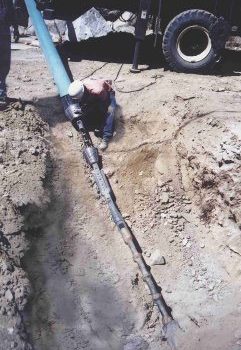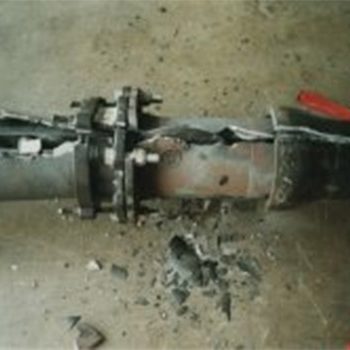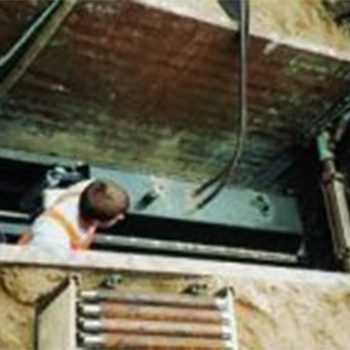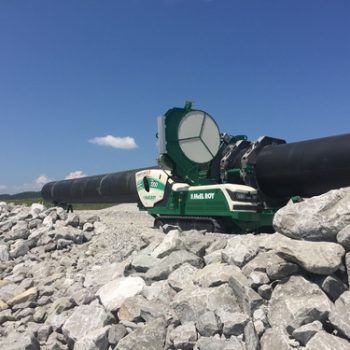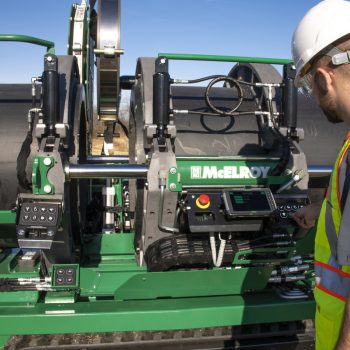In the beginning there was pipeline renovation. Unfortunately, various people pointed out that pipes which were structurally defective were often short of capacity too. Then there was trenchless installation which was ideal for new pipelines but relatively expensive compared with rehabilitation.
The old adage is “Make use of the hole in the ground,” so eventually someone had the idea of launching a percussive mole up the old pipeline to break and expand it, whilst simultaneously drawing in a new pipe string. The ‘someone’ in this case was British Gas (as it was once called) and D J Ryan, the company which currently holds the patent for the technique known as ‘pipebursting’ (or, in some countries, ‘pipe-cracking’).
Today, on-line replacement is one of trenchless technology’s major growth areas, and is used for both gravity and pressure pipelines. The development of systems that can operate from small chambers or excavations has increased the technique’s appeal.
BURSTING
Pipebursting is aimed at the on-line replacement, at size-for-size or for up-sizing, of existing pipes made from brittle materials, since the percussive action has to shatter the pipe and force the fragments into the surrounding ground. The new pipeline is generally polyethylene, either in fed from a coil or as a continuously welded pipe string. Most manufacturers of moling systems have pipebursting derivatives, examples of which include Vermeer’s PortaBurst system, DJ Ryan’s PIM system, Essig’s PCS system, Powermole’s pneumatic hammers fitted with a Pyramid bursting head, Terra AG’s Terra Hammer system and Tracto-Technik’s Grundocrack.
Although still popular, pneumatic systems do have limitations. To start with, a fairly long lead-in trench may be needed to accommodate the mole, and to allow the new PE pipe to be drawn in from the surface. Although PE is relatively flexible, large diameters and deep pipelines can necessitate long trenches which to some extent negate the ‘no-dig’ attributes of the system. Secondly, there is a limit to the extent of up-sizing, especially if there are adjacent services or if the pipeline is shallow and surface heave may be a problem. Thirdly, standard pipebursting equipment cannot cope with ductile materials which do not shatter, so repair clamps or sections of ductile iron pipe are likely to bring the machine to a halt.
A variation is hydraulic pipebursting, in which a hydraulic expander is used to break out the existing pipe, instead of percussive hammer action. Here the burster exerts an outward (radial) force to burst the old pipe. Operation entails alternately expanding and contracting the head, and jacking the pipes and burster forward. There are two possible advantages of this technique: one is that hydraulic expansion has less dynamic effect on adjacent utilities, and the other is that the expander is shorter than a percussive mole, so the system can be designed to operate from existing chambers or small excavations. To overcome the lead-in problem, short length PE pipes with ‘snap-fit’ joints are generally used such as that manufactured by Snap-Fit U.K. Ltd which now produces the Snap-Fit pipe originally designed by Clearline, although it is possible to install other materials including clayware. Naylor Revit pipes, similar in appearance to the company’s Denlok jacking pipes, have been developed for this purpose.
One of the main distinctions between percussive and hydraulic pipebursting is the method of applying forward thrust. Percussive methods generally rely on the hammer action of the mole to drive the machine forward, together with the pull from a winch attached to the nosecone of the mole. In hydraulic systems, thrust is provided by jacks in the launch chamber, which push the pipe string forward. Although a winch line is attached to the nose of the expander, its purpose is mainly to provide directional stability.
In the U.K., hydraulic pipebursting has become popular for the replacement or up-sizing of sewers and other gravity pipelines, with the ‘Expandit’ system developed by Clearline being the most common system. Although Clearline is no longer active other than in licensing production of the system, the equipment is still available through Perco Engineering Services.
ROD PULLING
An alternative to ‘active’ pneumatic or hydraulic bursters is to use a passive bursting head or splitting device attached to rods which are pulled through the old pipeline by a hydraulic rod-pulling machine located at the reception pit or chamber. There is a grey area here between bursting and splitting systems – many use either a knife/blade edge or a series of cutting discs (like large versions of glass-cutters) to split or break out the old pipe. Some are designed specifically for use in ductile materials such as steel, ductile iron or plastics, whilst other are aimed more at brittle pipelines but may have some capability in ductile materials.
The usual procedure is first to push the rods through the existing pipeline, and then to fit the breaker/splitter which is followed by an expander cone to which the new pipe string is attached. As with percussive pipebursting systems, the new pipe is generally coiled or continuously welded PE.
Examples of rod-pulling on-line replacement systems include Tracto-Technik’s Grundoburst, the Scandinavian No-Dig Centre’s T40 system, Vermeer’s Hydroburst and the Maxiburst and Miniburst systems originally developed by Clearline and Trenchless Replacement Services (TRS) rigs.
Some manufacturers have developed bursting heads which can be adapted to work with various rod pulling units and these include the Clampburster from D J Ryan and U-Mole, the ConSplit system, McElroy’s Bullet which in Europe are available from Pipe Equipment Specialists Ltd.
PIPE EATING/REAMING
There is an adaptation of microtunnelling known as ‘pipe eating’, which allows the on-line replacement of an existing pipe which is excavated by the tunneling machine as a new pipe is jacked in behind.
It is also possible to replace a pipe using a directional drilling machine – a technique known as ‘pipe reaming’ such as that with the Nowak system. Here the drill rods are pushed through the old pipeline, and a special reamer is then fitted. The new pipe string is attached to this via a swivel and towing head, and is installed during pullback as the old pipe is broken out.
The following is a selection of the companies and systems in the on-line replacement market today.
ESSIG
In addition to pneumatic moles for soil displacement applications and pipe ramming, Essig offers the PCS pipe cracking system which is suitable for the replacement of concrete, clayware and asbestos cement pipes from 150 to 500 mm diameter. It uses the company’s IP moles in conjunction with special cracking heads, and lengths of up to 120 m can be replaced in a single operation. Essig also offers a cutting head for splitting non-brittle materials.
McElroy
The ‘Bullet’, developed by McElroy Manufacturing, can cope not only with ductile iron pipe but also with fittings, couplings and flanges. A line of rotating cutting wheels, increasing in diameter along the length of the tool, allow the bullet to split the existing pipe and fittings, whilst a new PE pipe is drawn in simultaneously behind an expansion cone. Cutter wheels are manufactured from high-strength, shock-resistant tool steel for maximum durability, and all components are replaceable on site.
Versions of the Bullet are available for pipes from 30 to 150 mm diameter, and the system is capable of size-for-size replacement or up-sizing as required. Up to 100 m of pipeline can be replaced in a single operation. The Bullet operates in conjunction with conventional rod-pulling equipment, and does not require the use of impact or percussive devices.
SCANDINAVIAN NO-DIG CENTRE
The No-Dig Centre’s T40 pipeburster has a single hydraulic pipe ram which acts along the axis of the rods. This provides good stability in operation, and also allows the width of the machine to be minimized. The T40 measures just 225 mm wide, enabling its use in narrow excavations which reduce reinstatement costs and the risk of disturbance to adjacent services. This not only eliminates slippage and damage to the rods, but also increases safety by holding the end of the rod securely in the event of breakage.
The pipe burster comprises a cutting blade followed by a stop rod and expander, and can cope with brittle materials such as cast iron, clay and concrete. Special heads are available for ductile materials including steel and ductile iron. Renovation of pipes from 50 to over 315 mm diameter, and bursting lengths over 160 m, have been achieved. The cutting blade connects to the expander through a ball-joint to minimize flexural stresses, especially if an obstruction is encountered, and the rod joint is thickened to add strength in the region which is normally most susceptible to failure.
The T40 has a novel rod-gri Control is by means of a remote joystick which can be located above the pull-in trench, or from the powerpack itself. There is an emergency safety stop on the powerpack, and also a second stop which is remote and can be situated next to the pipe burster down the trench. A full electrical strike protection system is fitted which safeguards the operators in the event that an electricity cable is damaged by the burster.
On arrival of the cutting blade at the pull-in trench, a reverse lever on the T40 allows the machine to be backed up so that a ‘docking station’ can be inserted between the machine and the trench wall. The cutting blade and the PE pipe can then be pulled completely into the trench.
TRACTO-TECHNIK
Tracto-Technik offers pipe cracking and static pipe bursting techniques for water, gas and sewage pipes. The company has been engaged in pipebursting since 1981, and two main systems are now available.
Grundocrack pneumatic pipe cracking equipment is suitable for replacing all brittle pipe materials with new pipes usually made from HDPE. Although Grundocrack units in Europe are used primarily in the gas and drinking water industries, elsewhere the market has been developing strongly in the sewerage sector where the largest pulling accessories manufactured by Tracto-Technik are for a 1,200 mm diameter pipe.
Tracto-Technik’s Grundoburst static hydraulic pipe rehabilitation process is suitable for most materials including for steel and ductile iron pipes up to 200 mm diameter. Operating from a pit measuring just 2.2 m long and 0.6 m wide, the Grundoburst 400G has a thrust of 25 t and pulling power of 40 t. If more power is required, the Grundoburst 1000G has a thrust of 610 kN and a pullback of 1000 kN.
The Grundoburst equipment comprises a hydraulic jacking frame, a power-pack, Quick Lock bursting rods with a bore-head for thrusting, and various expanders for pulling in the new pipe. The expanders are available for pipe diameters from 100 to 200 mm, and HDPE pipe can be pulled in directly from the pipe trailer. The slotted Quick Lock rods cannot slip within the machine, and can be added or removed by one person without interrupting the pushing or pulling operation.
The old pipe is cut and split by a roller-blade head, versions of which are available for both pulling and pushing. The head can cut steel pipes, cast or ductile iron, polyethylene and even repair clamps. The normal method of operation is to push the rods through the old pipeline, and then split the pipe during pull-back whilst simultaneously drawing in the new pipeline. Small diameter pipes can be split during the thrust phase by using the push-type roller-blade head. The Grundoburst 400G rig is bi-directional, so pipes can be replaced in both directions from the launch pit without needing to turn the machine around.
D J RYAN/U-MOLE
D J Ryan, as previously mentioned were instrumental in the original development of the pipe bursting technique as well as development of the PIM system of pneumatic bursters. The company has utilized this system for over a decade in its contracting operations. More recently the company joined forces with U-Mole to develop and produce Clampburster, which overcomes the problem of bursting repaired sections of pipe safely using hydraulic rod-pulling equipment.
Traditional methods rely on increasing the pulling force on the pipe burster to pass through repaired sections. Often this leads to repair clamps being pulled through the ground until enough resistance is met to allow the blade and expander to pass through, or alternatively the resistance becomes too great and the burster comes to a halt. The resulting mass of broken fittings can cause damage to the PE pipe being installed.
Clampburster features a special eccentric profile and cutting blade that enables it to burst and open repair collars, clamps and fittings, folding them safely into the ground in the position they were fitted. The newly installed PE pipe suffers no damage from the burst repair sections.
Available in diameters of 3 in, 4 in and 6 in, Clampburster is compatible with any type of hydraulic pipebursting rig. The systems features easy-fit clevis and spade connectors to simplify connection to burster rods in the trench, and a heavy duty rear swivel for connecting to towing heads or up-sizing shrouds. Blade life is claimed to be in excess of 4,000 m, and replacement is by a single cap head bolt.
Clampburster can also burst continuous lengths of ductile iron and steel mains, using a slight alteration to the blade design.
